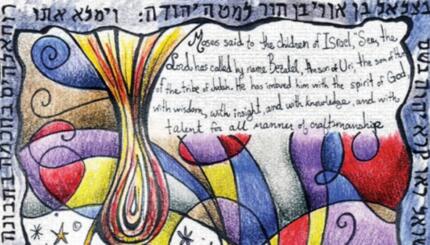The sacrificial lamb.
The last thing I imagined to find when I moved to Mississippi? A tabernacle.
Over the years, I’ve learned a lot about the Mishkan, the encampment the Israelites set up in the while wandering in the desert, the physical space where God dwelled among them. But I never thought I would see a life-size replica… let alone in Pearl, Mississippi.
I read about it online, and was immediately tempted to go see it—but I also felt a bit strange about the fact that this “life-size replica of the Mosaic Sanctuary that God gave instructions to Moses to build in the wilderness” was constructed by a Seventh-day Adventist organization. I wondered what the agenda might be, as the group travels with the tabernacle across the nation.
But my curiosity got the best of me. And so I went to see the Mishkan.
Located in the middle of a large open field, next to a church in Pearl, Mississippi, sat several large tents. Two kind older women welcomed me and handed me an admission ticket that read “tribe of Benjamin.” My father’s Hebrew name, I observed silently. The women asked me why I was in Jackson, where I worked and I told them about the Institute of Southern Jewish Life. Although I wasn’t trying to hide the fact that I’m Jewish, I realized I was a bit uncomfortable. Was I coming here “as a Jew”? Was I walking in as a student of religious studies?
Either way, I was probably not their intended audience.
Our tour guide began by explaining the history of the Temple, and Jewish worship at the Temple. I was impressed with the guide’s level of knowledge. He had a lot of dates and important figures memorized, and his information seemed consistent with what I learned in my Jewish day school education.
We walked into the tent, stopping to look at the altar made of “brass” (or plastic spray-painted to look like brass). An unfortunate plush-toy sheep was awaiting a demonstration. The guide explained to us the process of sacrifice, starting with the sin, and ending with the fats and innards burnt on the altar. He shared all the information I was familiar with, but his interpretation was different: for the tour guide in the church’s re-created tabernacle, every part of the sacrifice and worship to God somehow connected to Jesus’ ministry.
The tabernacle’s Holy of Holies.
We made our way through the tabernacle, beginning from the least holy spot to the most—the Holy of Holies.
Inside the Holy of Holies sat items I knew were supposedly there, but had never pictured. This was perhaps the most interesting thing for me; to see things like manna and Aaron’s staff, depicted in material terms. Manna is something I’ve always learned about as maybe bread, or maybe grain, but definitely heavenly, other-worldly. To see it in a bowl, so obviously of this world, was confusing. Some of the mystery, the ineffable quality was lost.
Perhaps the most jarring interpretation of all: the tour ended in a tent where the High Priest was dressed in a breastplate—and instead of pomegranates and bells around the bottom of his frock, instead Christmas ornaments dangled from the garment.
It was an odd experience, but I’m glad I went. I left this Mishkan feeling confused, but also full of pride. Though our religions look very different today, the Christians who created this tabernacle share many of the same historical roots that connect me to my faith. For my tour guide, the Mishkan was an extraordinary thing that led the way for Jesus’ salvation. For me, it was something that helped shape my people, as a people. Christianity and Judaism both changed drastically over the years, and neither look much like the religion practiced in the desert for 40 years—but both still find meaning in memories and experiences of the Mishkan.
Like this post? Join the conversation through MyJewishLearning’s weekly blogs newsletter.


